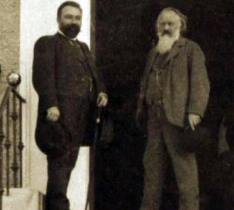Our April concert features flights of fantasy—famous duos, and a trio, that are the products of special relationships between prominent pairs and peers: players with composers, composer and composer, and player with player.
The duos are Franz Schubert’s late Rondo for Violin and Piano in B minor (1826), Zoltán Kodály’s early Duo for Violin and Cello (1914), and Claude Debussy’s Première rhapsodie for Clarinet and Piano (1910). The trio is Johannes Brahms’s Clarinet Trio in A minor, Op. 114 (1891), long a favorite at BCMS.

Brahms was the pianist at the premiere of his Clarinet Trio in 1891, the first of four great works he was to write for clarinetist Richard Mühlfeld, whose consummate artistry coaxed him out of retirement.
Invited by Gabriel Fauré, then the head of the Paris Conservatoire, to create a challenging solo work for clarinet in 1910, Debussy’s Première rhapsodie is appreciated today in its first piano version, and with Debussy’s later orchestration (1911), for its wide expressive range of character and color.
Without the coincidence of two young and adventurous Hungarian composers (Kodály and Bartók) willing to travel the countryside in search of the roots of what would become their national style we might not have the folksy improvisation and children’s song that inform the Duo for Violin and Cello. Virtuosity and imitation, both competitive and cooperative, is the manner in which pairs and peers relate.
Franz Schubert really must have been taken with Josef Slavik, who was both a violin virtuoso and a composer often favorably compared to Niccolò Paganini. The Rondo in B minor and the great Fantasy in C major were written by Schubert for Slavik. It is certainly a show of youthful endurance lasting, as a single movement, about fifteen minutes of great tunes, high-kicking antics, ambiguous harmonies and false endings to prolong the fun!
Enjoy.
